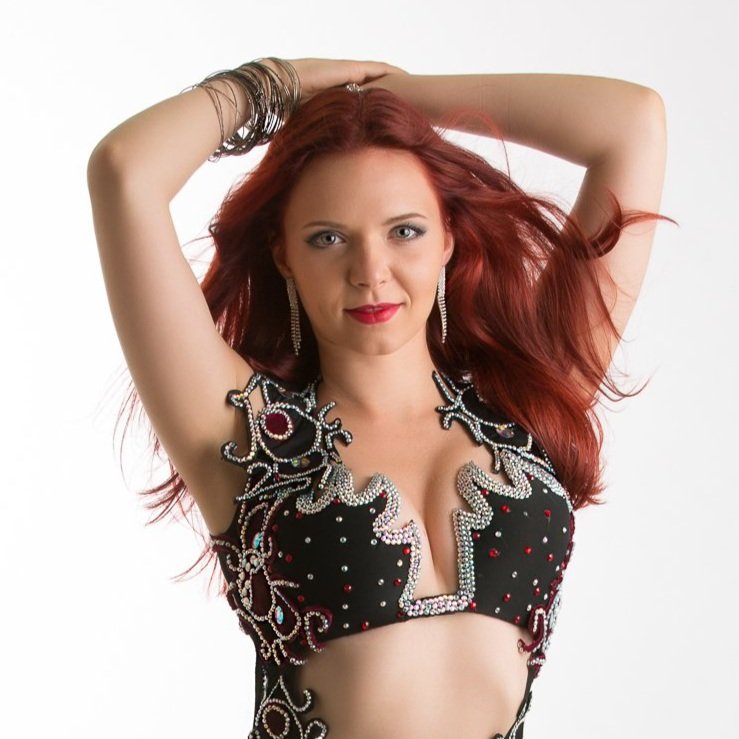Tips on Belly Dance Improvisation
“Improvisation?! No way! I’m too afraid! What if I look silly?! What if I freeze on stage, or miss all the accents?” - Are those thoughts familiar? It’s interesting how contrasting the dance nature is: some dancers prefer only to improvise, and some dancers can’t even think about possibility of going on stage and doing an improvisation…⠀
If you can relate to the second type of dancers, then here are some useful tips for you on how to handle the improvisation time better:
Calm down. Whether you are performing at a competition or in a restaurant, it is important to remember: you will not die if you “misinterpret” that song, nobody is gonna kill you if you don’t catch absolutely every singly Dum and Tak. Lol. Of course, it’s normal to have butterflies in your belly before going on stage. It simply indicates that you care about your performance. But there is no benefit in exaggerating it. Life will still continue after this improv performance. Treat it simply as one of your learning experiences, and an opportunity to step out of your comfort zone and hence one step closer to your dream dance level. And always remember: this moment will pass too, and tomorrow it will be just a memory.
Enjoy it. This trick I use not only for improv, but also whenever I perform some unusual style that my audience is not familiar with, and I worry if they will enjoy it, and not think that it was simply weird. In such case, I always give myself a mental note before going on stage: “ Whatever! First of all, I should make it fun and enjoyable for myself, and even if nobody else enjoys watching me… well, at least I’ll enjoy dancing it!” And believe it or not, once you immerse in every second of your experience on stage, the real magic happens…
You are not a Nostradamus. If you are dancing to an unfamiliar song, or to a live band improvisation, don’t try to predict what’s coming up. Just stay tuned to hear it and process through your body as fast as possible. In fact, it’s even ok to be a tiny “delayed” after the music. I remember when I was participating in one of Arabesque Company’s production in Canada, director Yasmina Ramzy gave me feedback that I was too much “perfect” with my timing of movements. She mentioned that even despite all pieces were choreographed, the idea is to create an illusion of improvisation, so how could a dancer move her body before the music queue her to do so? And if this applies to choreography, what to tell about an actual improvisation?! Hear it first, then reflect.
Slow down. When we are nervous, the tendency is to rush. But even when you have an actually fast song to dance too, it doesn’t mean that you need to shake all the time. Slow down in your movements. See if instead four hip drops, one big undulation can do the trick to the same music part. Such visual “pauses” and moments of calm add texture to your dance, make it varied and interesting to watch, as well as give your audience’s eye a chance to rest and refresh their attention before the next killing part!
Less is more. Same way as with speed itself, don’t rush to show all belly dance movements you’ve learnt. You don’t need to pack dozen of movements in 5 seconds of your improv to make it impressive. Imagine you have guests who came over for a dinner. Would you serve appetizers, main dish and desert all at the same time? Probably not. Same applies to dance. Stretch your movement vocabulary throughout the dance, introduce a new idea one at a time, and give an opportunity for your audience to actually see it. And then they think they got it, surprise them with something new!
Listen to all melodies within the song. Every song usually consists of various melodic themes. Often we get too stuck just on the main melody, or even worse, just on the drum part of the song, and miss all beautiful ornamentations on the background. Be aware of those moments: maybe a violin took over, and started playing an intricate taksim on the background, or maybe qanun or oud. Often dancing to a separate instrument can help you to slow down, avoid constant repetitions, and to translate melody to the audience in its full richness.
Don’t forget about your audience. You actually don’t need to constantly dance. You can take a moment and interact with your audience. Remember: there are indeed people who are watching you. And they can be either your “enemies”, if you are afraid of them to death, or you can transform them into your “allies” and support you. Just a simple turn of head indicating that you are watching them as well, or a blink of an eye, or a smirk smile… Such acting tricks can easily destroy the wall between you and your audience, make them feel that they are a part of the act too, and ease the atmosphere and particularly help with your nervousness.
Two magic moves. Let’s finish on a very practical note. There are moves that miraculously work with almost any music: turns and shimmy. If at any moment of your improvisation you feel completely lost, or panicking, use either of these moves, whichever feel more right to a particular moment in the music, as your emergency tool in order to refocus, get back in a moment, and keep going with your improvisation once you are ready. In 90% of cases it will work.
I hope these tips were helpful! Good luck with your dance explorations, and if you have any improv tips of your own, feel free to share in comments below!
If you enjoyed this article, don’t forget to like and share! :)
Author: Iana Komarnytska
Photographer: Pedro Bonatto
Master your drum solo improvisation with a special intensive at the Iana Dance Club! In this program we will work on your mindset and fear of improvisation, breakdown the structure of a drum solo, and take a detailed look at each part, have lots of practice, theory and assignments! Find more information HERE.
YOU MAY ALSO LIKE:
LISTEN TO THE BELLY DANCE LIFE PODCAST:
About Iana
Iana Komarnytska is a professional dancer, teacher, choreographer, and passionate content creator helping dancers navigate their dance lives.
She is a graduate from the professional dance program at York University (Canada), host of the Belly Dance Life podcast, creator of the Iana Dance Club, author of numerous articles, and winner of Star Bellydancer Canada 2014 among other international competitions.
Along with belly dance, Iana performs and teaches Persian Classical and Turkish Romani dancing. She is the first choreographer to start using Triple Isis wings, and since 2012 this is one of her style signatures.











If you are dancing to an unfamiliar song, or to a live drum solo improvisation, don’t try to predict what’s coming up. Just stay tuned to hear it and process through your body as fast as possible